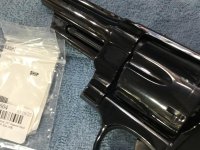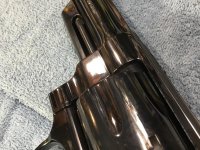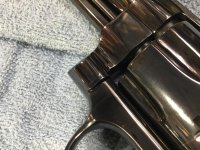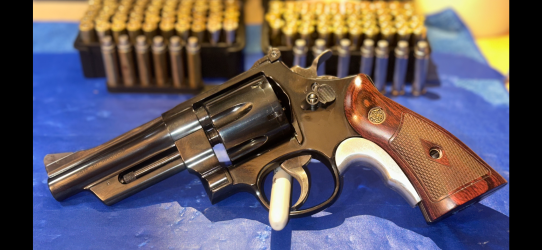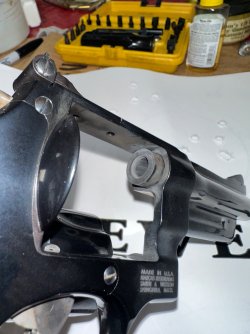-
Forum Update: We've upgraded the software to improve security, performance, and the overall experience.
👉 Read why we made the change | Support the Forum
You are using an out of date browser. It may not display this or other websites correctly.
You should upgrade or use an alternative browser.
You should upgrade or use an alternative browser.
27-9 Classic flame cutting, etc.
- Thread starter RickB
- Start date
Here’s the envelope of the replacement screws. Forster brand, can’t remember the vendor. I’ve only shot this gun maybe 50-75 rounds and probably half were .38 spl. It’s hard to see the burn marks with a cheap IPad camera, but they’re there. I keep forgetting about taking it to a smith.
Attachments
Contacted S&W customer service, and received a, "Sure, we'll send you a couple of longer screws." OK, so that's an improvement from ignoring my request that they replace the screw while they had it.
The screw package indicates the screws are .010" longer, the screw was easily installed, there was no loctite.
Took the gun to the range yesterday, having dithered for a couple of months.
There are still distinct circular marks between the cylinder flutes, but it cleaned without abrasives or excessive scrubbing.
How did it shoot? Without any load development, using components on hand, I was able to put the last eight rounds of 50, into 3.75" at 50 yards. I think there must be a bullet/powder combo that will shoot into 3".
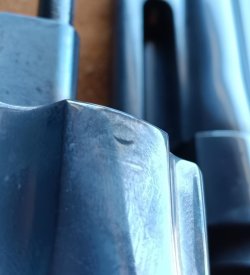
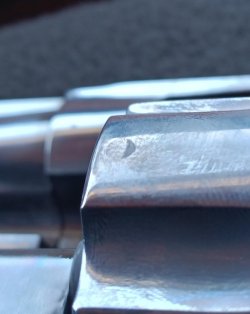
The screw package indicates the screws are .010" longer, the screw was easily installed, there was no loctite.
Took the gun to the range yesterday, having dithered for a couple of months.
There are still distinct circular marks between the cylinder flutes, but it cleaned without abrasives or excessive scrubbing.
How did it shoot? Without any load development, using components on hand, I was able to put the last eight rounds of 50, into 3.75" at 50 yards. I think there must be a bullet/powder combo that will shoot into 3".



Hill536
SWCA Member
A buddy of mine was showing me the PC 629 he just picked up Thursday. Nice revolver BUT I pointed out the same short screws holding the sight to the frame, the posts here highlight. Same marks on the stainless cylinder. Don’t think he was too happy …. but this thread proved useful.
The screw is a #6-48 which is an Extra Fine thread pitch that is rarely stocked at your typical hardware store. Brownell's is the most reliable source for these screws. As for removing a screw that has been loctited in place, that is very simple. Put the EMPTY gun in an oven set to Warm and heat it up until it's in the 130-150 degree range. Put on some gloves and then loosen the screw and it will come right out. Note, steel springs have to be heated to a minimum of 380 degrees in order to have any effect on a "Spring Temper" so 150 degrees is perfectly safe.
Personally I've never been bothered by the flutes on the cylinder getting sooted up due to that screw. It takes far more time getting the face of the cylinder clean than a simple pass with a patch soaked with Ballistol that is all the fluting requires.
Springs are tempered at around 700 to 800F 380 F would just barely soften a file. 380 C on the other hand is 716F
Like he said.........No big deal..........Eventually it will stop........Most of my old magnums have it.......Of no concern to me.I just don’t worry about. Mine are shooters and all the newer smiths in the last 25 years or so do it. A longer screw will help
SWFan27
Member
S&W sent me replacement screws for my 66-8 and 19-9. They are not the same screw. The 19-9 has a slightly thicker top strap.I've seen some videos showing discoloration to the exterior of the cylinder, between the flutes, apparently caused by gases "swirling around" the hole in the top strap for the screw that retains the rear sight.
Older Smiths have the screw farther forward, and the hole is not drilled completely through the top strap, so it's not an issue.
My gun is back at the factory for a trigger issue, but my letter describing the top strap/hole/screw asks for a longer screw that fills the hole flush.
Is S&W likely to respond with, "We've installed the longer screw designed to prevent that issue", or something more like, "We don't know what you're talking about"?
Anyone else have the issue and tried to apply a home remedy?
My first thought was filling the screw hole with epoxy, but then I thought about trying to get a replacement screw, cutting a few threads off and making a headless screw to fill the hole.
SWFan27
Member
There is no damage. Just a cleaning issue which is no problem for stainless revolvers, but blue revolvers need something like the ProShot metal polishing cloth to remove the marks.Does anyone have a picture they can share of the damage that is caused by this issue?
bigggbbruce
Member
If you would like damage be sure to use a metal polish.There is no damage. Just a cleaning issue which is no problem for stainless revolvers, but blue revolvers need something like the ProShot metal polishing cloth to remove the marks.
Shoebox1.1
Member
- Joined
- Apr 1, 2023
- Messages
- 308
- Reaction score
- 688
Shoebox1.1
Member
- Joined
- Apr 1, 2023
- Messages
- 308
- Reaction score
- 688
SWFan27
Member
The ProShot metal polishing cloth is soaked in some sort of clear liquid that wipes the cylinder marks right off without damage to the bluing. The package says safe for factory blued finishes. It was recommended to me by someone on the forum.If you would like damage be sure to use a metal polish.
Similar threads
- Replies
- 9
- Views
- 682
- Replies
- 21
- Views
- 2K


